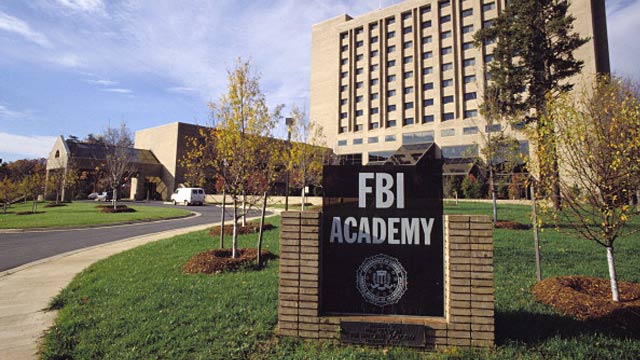Becoming an FBI Special Agent is a complex process that involves several elements. Once the Bureau announces that it is hiring and you feel that the call is for you, you need to be prepared for all of the requirements and elements of the competitive selection process. You can be disqualified based on the background check or because you fail the physical fitness test.

If you make it through the selection process, however, there is still no guarantee that you will get the dream job of a special agent. There is one more hurdle to overcome and that is the new agent training at the FBI Academy in Quantico, Virginia.
Below you will find some interesting information about the history of the Academy, what types of training it offers, and what does it take to graduate the FBI Academy in Quantico.
History and Development of the FBI Academy
Being referred to as the “West Point of Law Enforcement”, the FBI Academy is one of the most renown law enforcement training institutions. It has a long history, dating back to 1934 and evolving through the decades to become the modern 547-acre facility it is today.
- How did it start?
The story of how the idea about a training academy was born sounds a bit like a movie plot. In June 1933, three police officers and one FBI agent were killed when escorting a prisoner through a Missouri train station by criminals who opened fire on them. As a result of the so-called “Kansas City Massacre” and the public reaction to it, FBI agents were allowed to carry weapons for the first time and were empowered to make arrests. Hence, came the need to teach the agents marksmanship.
In order to be able to practice at a safe place, the Marine Corps allowed the FBI to use their firing ranges on its base in Quantico, Virginia. This was in 1934 and the FBI Academy is still located there, though in a much different setting.
- First innovations
Being able to learn marksmanship was important for the agents, however the Bureau soon realized that it will be of great benefit to train their employees in other skills as well. Thus, the first classroom was built in 1940. Throughout the following years other facilities such as a dining hall and a dormitory were added. Then in 1969, began the construction of what is now the real base of the Academy. The new complex was opened on May 7, 1972.
This is the time when real training began at the Academy, which due to its expanded premises was able to host larger classes of up to 200 people, including trainees from oversees. The new complex featured important upgrades such as new classrooms, a 1,000-seat auditorium, a fully equipped library, a new firing range, gym and swimming pool. Of high importance were the specialized facilities that allowed forensic science training, along with darkrooms, and a mock-city classroom and a crime scene room.
“Hogan’s Alley,” a mock training town, was built in 1987, allowing agents to train in a realistic setting. A bit later, the complex was expanded to host the Engineering Research Facility and the Critical Incident Response Group, part of which are the Hostage Rescue Team and behavioral scientists.
The Intelligence and Investigative Training Center was established in October 2001 as a result of the increased need for more advanced intelligence skills and knowledge. Now, the Center provides three levels of training to intelligence analysts and special agents: basic, intermediate and advanced.
- Modern infrastructure
Gradually, the FBI Academy become a state-of-the art training center, which includes the best technology, facilities, and nearly 600 training staff, comprising of special agents, intelligence analysts, and other professional specialists. The first stand-alone lab building was opened back in 2003 and since 2007 more improvements were made to the older base, including the dormitory, the class rooms and the firing range. Innovations, such as virtual reality, are also part of the training and simulations for the new agents.
Now, FBI Academy provides training in three different divisions: New Agent Training; intelligence Training, and the National Academy.
New Agent Training – What Does It Take to Graduate the Academy in Quantico
The first and most important function of the FBI Academy is to train the new agents for the job they are going to be embarking upon. The aim is to teach them to serve and protect, using various skills and knowledge, while being committed to respect the US constitution and the laws they enforce, and show understanding and compassion to the people they are encountering.
Despite the tough selection process, How to Become an FBI Agent, there is no guarantee that all trainees will finish the Academy or that all who graduate will get the dream job of a Special Agent. If the candidates are not performing well in any of the four main areas in which they receive training, their journey of becoming an FBI Agent will end they they will be sent home.
The overall training covers 20 weeks or a total of 850 hours of instruction. There are four main areas that are covered: Academics, Case Exercises, Firearms Training and Operational Skills, and Physical Training.
So, what it takes to graduate the FBI Academy? Here are some details of the courses as per the official FBI site information.
- Academics
The academic courses cover a great variety of subjects that aims to teach prospective agents the fundamentals of law, behavioral science, ethics and forensic science. They develop practical skills related to interviewing and report writing as well as more specific knowledge about using investigative and intelligence techniques and interrogations. Since the aim is for the new agents to be able to handle almost any situation, they are also thought how to deal with counterterrorism, counterintelligence, weapons of mass destruction, cyber, and criminal investigations.
The ethical part of the job is also a very important element in the training of the new agents. They need to respect civil equality and safeguard the core values of law enforcement.
- Case Exercises
In order to experience real-life situations, trainees participate in case exercises. The mock town of Hogan’s Alley is used for this purpose and actors play the roles of criminals and terrorists. Trainees have the opportunity to chase and arrest subjects, and at a later stage they can also practice their skills to present evidence in a moot court.
Various scenarios are developed and followed using the latest technology for more efficient training, such as virtual reality.
- Firearms Training and Operational Skills
Since 1934, FBI Agents were allowed to carry weapons and hence the necessity to train them to use firearms. As part of the Firearms training module, all prospect agents learn how to use all FBI-issued weapons that include pistol, carbine, and shotgun. The instruction is not only on marksmanship but also covers areas such as weapons orientation and handling skills, in addition to the practical shooting techniques. There are a total of 110 hours of instruction divided into 28 sessions. The trainees must successfully pass the test with both a pistol and carbine and participate in a shooting scenario with a shotgun.
In order to learn operational skills, the trainees pass through 90 hours of instruction and practical exercises. The areas covered are very broad and include safe driving techniques, boxing, handcuffing, searches, surveillance, weapon retention, etc. Hogan’s Alley is used for real-life scenarios that include daytime and nighttime surveillance, dissemination of intelligence, street survival or arrests. Using pain-guns instead of real weapon, the trainees participate in mock events such as bank robbery or kidnapping.
The overall aim is to cover a maximum of scenarios that the Special Agents will encounter in their future career in the Bureau.
- Physical Training
The job of the Special Agent requires the candidate to be in great shape in order to meet the physical challenges such as chasing and detaining a suspect. Therefore, fitness training is an essential part of the overall instruction at Quantico. At the end, all trainees must pass a standardized physical fitness test (PFT). The passing score is 12 points, which are divided between four areas:
-number of sit-ups for one minute
-untimed push-ups
-timed 300-meter sprint
-timed 1.5-mile run
Instruction in all four fields is provided by full-time instructors from the Training Division and by experts in counterterrorism, intelligence, forensics, and other areas from across the Bureau. There is also a group of special agents from the field offices who help the new trainees with advice and support them throughout their stay. They are called field counselors and change on a rotating principle.
Upon completion of the training program, the attendees graduate at a special ceremony, which is open for their family and friends as well. There, the FBI Director or his representative swears in the new agents and gives them their badges.
This however, is not the last time the Special Agents will visit Quantico, since their training continues throughout their career.
Intelligence Training
After the terrorist attack of 9/11 the FBI placed its major focus on intelligence-related activities. Hence, the second division of its training center at Quantico is dedicated to the preparation of intelligence analysts. The programs provide both basic and advanced training of the experts in the field. The focus is on different techniques and modern technologies for collection, analysis, and dissemination of intelligence. The overall goal is to improve the practices of prevention and combating security threats.
Intelligence analysts, employed by the Bureau, receive complete training at the beginning of their placement and continuous training throughout their professional development in this job. This instruction focuses on four main aspects:
- Operational doctrine
- Tradecraft
- Relevant policies
- Basic guidelines underlying the FBI intelligence mission
In addition to that, this division of the Academy also focuses on building relationship between the intelligence analysts, the FBI Special Agents, and the rest of the employees at the Bureau as well as with the broader intelligence community.
FBI National Academy
The FBI National Academy is a special division that aims to help active US and international law enforcement officers enhance their knowledge in the field, raise the common standards and grow their cooperation worldwide.
It was created back in 1935 along with the very establishment of the FBI Academy. The first training session was dedicated to criminal investigation techniques, scientific aids in crime detection, report preparation and administration/organization and was attended by 23 students.
At present, there are 250 trainees who attend the Academy four times a year. The students come from the management of local police or sheriff’s departments from all over the USA and from more than 150 international partners. The training lasts for 10 weeks and offers courses in:
- Law
- Behavioral science
- Forensic science
- The terrorist mindset
- Communication
- Health/fitness
- Leadership development
It is interesting to note that during World War II, there were courses in espionage and sabotage added to the curriculum.
Upon graduation, the attendees become part of the FBI National Academy Associates, which features more than 15,000 law enforcement professionals.
Now, at the end of the program there is an optional fitness challenge called “The Yellow Brick Road”. It is a test of the physical fitness of the attendants and is a 6.1-mile run through a cross terrain that includes lowlands, woods, muddy water and artificial hurdles mimicking jumping through window and over walls or crawling under barb wire. Those, who finish the track successfully receive a yellow brick as an award and symbol of their achievement.
The training at the Academy is at the highest possible level to ensure the great results of the future Special Agents, employed in the various departments and units of FBI. The Academy guarantees that all active agents and law enforcement officials from various agencies are provided to most up to date training.

 Joseph Libowsky,
Joseph Libowsky,